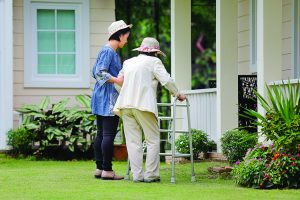 Healthcare systems are changing, with radical implications for family caregiving. Cost-saving reductions in hospital stays ensure that patients are discharged “quicker and sicker.” Management of complex chronic care thus moves to the home, and responsibility for that care shifts from medical professionals to family caregivers. US family members have always provided the bulk of long-term care for older adults (around 80 percent). Now, in addition to assistance with activities of daily living (ADL) (e.g., bathing, grooming) and instrumental activities of daily living (IADL) (e.g., cooking, housekeeping), caregiving involves complex medical/nursing (M/N) tasks. Approximately 60 percent of family caregivers provide M/N care, which includes assistance with complex medication regimens, mobility devices, special diets, wound care, medical equipment (such as ventilators, oxygen tanks, suctioning tubes), catheters, IV fluids or meds, injections, blood glucose monitoring, tube feedings, home dialysis and ostomy care. Of those providing M/N care, approximately 35 percent perform three to four M/N tasks; 26 percent perform five or more.
Healthcare systems are changing, with radical implications for family caregiving. Cost-saving reductions in hospital stays ensure that patients are discharged “quicker and sicker.” Management of complex chronic care thus moves to the home, and responsibility for that care shifts from medical professionals to family caregivers. US family members have always provided the bulk of long-term care for older adults (around 80 percent). Now, in addition to assistance with activities of daily living (ADL) (e.g., bathing, grooming) and instrumental activities of daily living (IADL) (e.g., cooking, housekeeping), caregiving involves complex medical/nursing (M/N) tasks. Approximately 60 percent of family caregivers provide M/N care, which includes assistance with complex medication regimens, mobility devices, special diets, wound care, medical equipment (such as ventilators, oxygen tanks, suctioning tubes), catheters, IV fluids or meds, injections, blood glucose monitoring, tube feedings, home dialysis and ostomy care. Of those providing M/N care, approximately 35 percent perform three to four M/N tasks; 26 percent perform five or more.
M/N caregivers are stressed. They worry they will make a mistake or hurt their care receiver. M/N tasks are emotionally difficult, especially pain management. Demands of providing special diets and incontinence care are constant and unending. Considerable skill is required to master complex procedures, recognize complications and side effects, and know when to seek additional help. Most claim they learned M/N tasks on their own. Peer support is rare. Although mandated in most states, caregiving instruction at hospital discharge is typically limited by time constraints to the most complicated tasks (tube feeding, suctioning, managing IVs), with less attention to more constant and anxiety-provoking demands, such as incontinence care or special diets.
Decisions regarding severity of need and allocation of services should consider M/N tasks, in addition to ADL and IADL.
A number of resources are available to reinforce initial M/N training:
M/N Caregiving Instructional Videos and Resource Guides
Home Alone Alliance™
Videos on incontinence care, specialty diets, etc.
www.aarp.org/nolongeralone
Supporting Family Caregivers: No Longer Alone Videos on wound care, injections, etc.
https://journals.lww.com/ajnonline/pages/collectiondetails.aspx?TopicalCollectionId=38
Reports:
Caregiving in the United States 2020 by AARP, National Alliance for Caregiving
https://doi.org/10.26419/ppi.00103.001
Home Alone Revisited: Family Caregivers Providing Complex Care by Reinhard, S.C. et al. (2019), AARP
https://www.aarp.org/ppi/info-2018/homealone-family-caregivers-providing-complexchronic-care.html
CENTER ON AGING — University of Hawai‘i at Mānoa
2430 Campus Road, Gartley Hall, 201B, Honolulu, 96822
808-956-5001 | map3@hawaii.edu
www.hawaii.edu/aging


Leave a Reply